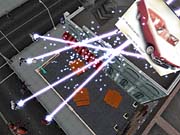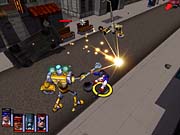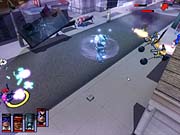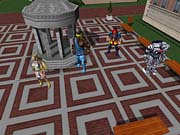Freedom Force Designer Diary #6
Lead designer Jonathan Chey details the process of putting gameplay into the game.
Entry #6 - 06/08/01
By Jonathan Chey
Lead Designer, Irrational Games
Hi and welcome to another installment of the Freedom Force developer diaries. In this diary, I want to return to the place where we started a year ago and get back to the nuts and bolts of the process of designing the gameplay in Freedom Force. We're going to dig a little deeper into some of the issues that will make Freedom Force fun to play.

We've just returned from E3, and we had a great showing there. The most important thing it did for us was to validate our own notions of what Freedom Force is becoming. At the show, people were able to wander up to the game, start mucking around, and figure out what to do without having to be told what keys to press or how to play the game. And they were able to start having fun without being told how. That tells us that we're on the right track with our basic gameplay mechanisms and interface.
But how do we go about extending those basic mechanisms while coming up with 25 interesting missions? If we could answer those questions in detail, we'd have a recipe for making great games. It certainly isn't easy, but right now, I'd like to touch on some basic design elements that we use in Freedom Force.
Let's start with the fuzzy area of player intention. Intention is one of those tricky concepts that is hard to get right, sounds relatively unimportant, but can really make or break a game. When it's clear, you don't notice it. When it's not clear, the whole game is broken.

What we mean by intention is that the player should always know what he or she is trying to achieve and should have the tools to formulate a plan to achieve his or her goals. Most first-person shooters, for example, don't have too much trouble with this because the game format doesn't present this as a huge challenge--the player's intention is to kill all the monsters and find his way through to the end of the level. Generally, the levels are structured so that the player has a simple, fairly linear path through the level, so it's always pretty clear which direction to go in. Other kinds of games have to work a little harder, like open-ended RPGs with multiple quests or tasks and free-roaming maps. Poor "intentionality" in such a game would result in a situation where the player has no idea what to do next to advance his or her quest, where to go, or whom to talk with to move the plot on.
In System Shock 2, we had to work quite hard to ensure that the player's intentions were always directed appropriately because the goals are constantly changing and are quite complicated. In addition, the player could traverse back and forth between levels that were deliberately nonlinear in form. This could have easily led to incredible confusion in which the player is unsure what to be doing at any given time, let alone how to do it. To get around this, we gave the player a number of tools: a database of logs that the player could access and replay at any time, a list of "quests" showing which had been achieved and which were still outstanding, and a map that showed quest locations and functional objects, such as recharging stations and med beds.
In Freedom Force, our problems are considerably less complicated due to the shorter nature of the missions and the smaller size of the maps. Player objectives are always available on an objective screen, so high-level player intentionality is unlikely to be a problem. If problems are going to occur, they are likely to be at the level of trouble converting that intention into action. A good example of this kind of problem is the "bug hunting" task required in X-COM. In X-COM (one of my favorite games of all time), the otherwise excellent missions occasionally degenerate into tedious searching across the map to find a hidden alien because the player isn't provided adequate tools to find enemies.
In order to solve this kind of problem, Freedom Force originally contained a pretty standard "minimap" interface element that showed the player a 2D projected map of the current level and indicated special locations (like enemies) on the map. However, this map was far from ideal--it took up too much screen space and was also small and fiddly. So shortly before E3, we replaced it with a simpler and more focused interface element--big red arrows that point at the next "hotspot" for the player to investigate. These arrows are always configured specifically for the mission in question. If the enemies are secondary objectives, they are not "arrowed"--but if the objective is to hunt them all down, then arrows will always be provided to help locate them. This allows the player to focus on his or her real task--figuring out how to defeat the enemies not searching for them.

So the real point here is that we need to align our game design to focus the player on the tasks that are fun and that we want him or her to work on. If our game were about subhunting, then searching and tracking down the enemy would be a core gameplay element. But in Freedom Force, the core gameplay experience is using your characters to battle the enemy in interesting tactical situations. The objective of the rest of the game is to deliver the player to those tactical situations in an interesting way that connects them together in a believable and intriguing story arc.
So what can we do to enhance the interest of the actual tactical situations? Let's look at one of the major foci for us in Freedom Force: utilization of the environment.
The simplest game environments, still prevalent in many (or most) games, are those in which the world is divided into go and no-go zones. From a gameplay point of view, these games could really be represented by black-and-white regions on the screen. In Freedom Force, we want to go way beyond that and make the world meaningful. We want a combat that takes place in an alleyway to feel very different from one that takes place on a rooftop or one that takes place in Times Square.
We can achieve this with two tools: first, the actual 3D terrain in the environment, and second, the objects that we populate the world with. Unlike many games, Freedom Force really does have a lot of vertical scale in the environment--basically, there are lots of buildings, and they are tall. And in Freedom Force, some characters have the power to travel up and down in that space freely (by flying, climbing, or jumping), and others do not. This immediately gives meaning to the buildings--they can be used as platforms for shooting at people who can't climb them or for dropping things onto them. So, the location, number, and height of buildings are critical to the structure of combats in the area.

Stepping down a level, the other key factor to the environment is the objects that are lying around: from cars to dumpsters to fire hydrants. These add meaning to the environment in several ways: They provide cover behind which you can shelter, they can be used as weapons, either thrown or swung, and some of them have additional secondary effects. For example, a car is a great throw weapon because it is so heavy. It also provides cover from enemy fire. An electrical substation, however, is a bad thing to shelter behind. But it makes a good trap to use against robots.
So instead of being satisfied with a blank combat arena, using these simple tools, we can set up interesting environments that make sure that each combat plays out slightly differently. It's boring to fight the same robots three times in a row, but it's cool if each time presents a different problem because of the environment and tools available in it.
Well, that's a brief look at some of the ways we are thinking about Freedom Force design as we head into alpha. We'll be back with more soon!
Got a news tip or want to contact us directly? Email news@gamespot.com
Join the conversation